A large number of medicine bottles were recovered from this shaft feature. Many of these bottles contained information that helped to identify the different medicines that the occupants of this household relied on to prevent and treat various illnesses and recurring symptoms.
Medicinal bottles can be divided into two main groups: druggist bottles and patent medicine bottles. Druggist bottles contained prescription medicines produced by individual druggists and pharmacies, and typically circulated within a small geographical area. Patent or proprietary medicine bottles typically contained products that were sold over-the-counter and without prescription. Medicine bottles of both types were recovered from the shaft feature on the property at 1018 Palmer Street.
Druggist Bottles
These medicinal compounds would have been distributed solely based on a doctor or pharmacist’s diagnosis and prescription. While the heyday of such proprietary druggist bottles existed between the 1870s and the 1920s, earlier examples certainly existed, and typically bore embossing featuring some combination of the name of the druggist, store, and location. Such bottles have also been termed pharmacy, drugstore, or prescription bottles.
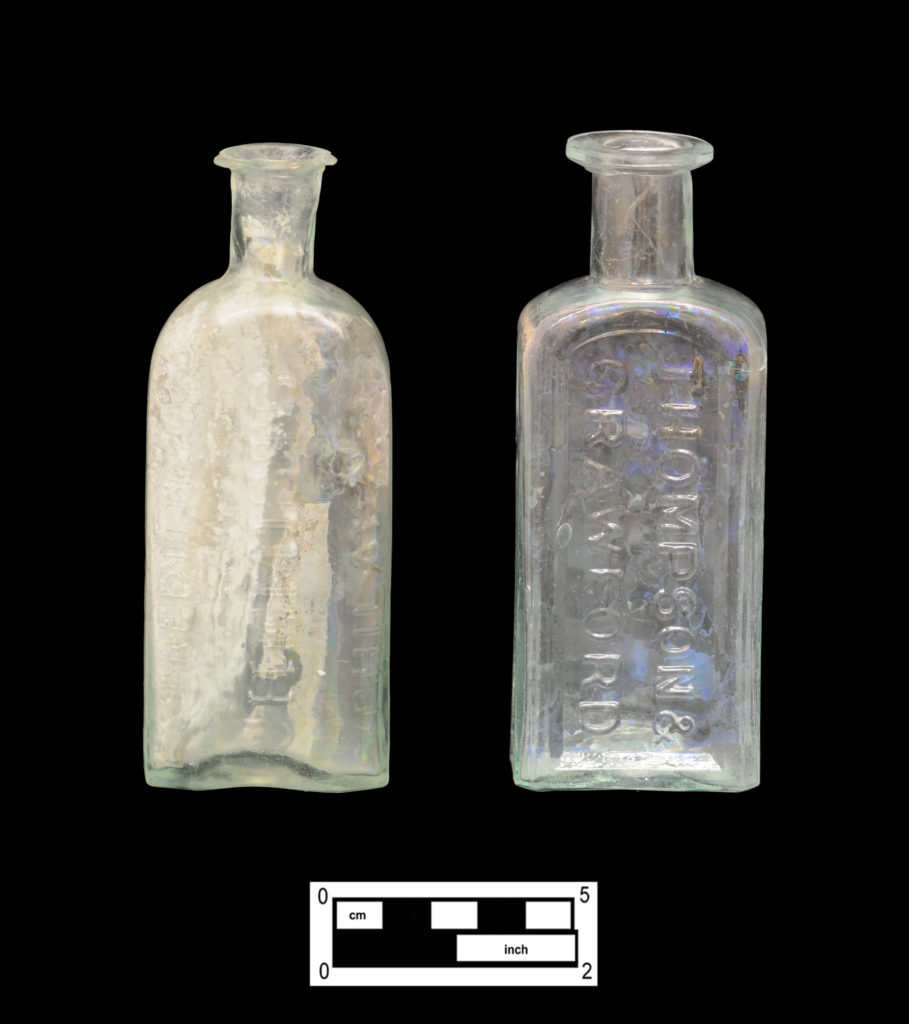
This small bottle, marked “E. MEREDITH & CO / CHEMISTS / PHILADA.,” was produced by druggists Edwin Meredith & Company, who operated on Market Street in Philadelphia from 1843 to 1850 (4A-G-0018) (Figure 1). 1 Three small paneled medicine bottles filled by other Market Street druggists Thompson & Crawford were also recovered from Feature 2, and were likely sold sometime between 1846 and 1861, when the partnership was listed in the city directories (4A-G-0275; 4A-G-0328; 4A-G-0329) (Figure 1). 2
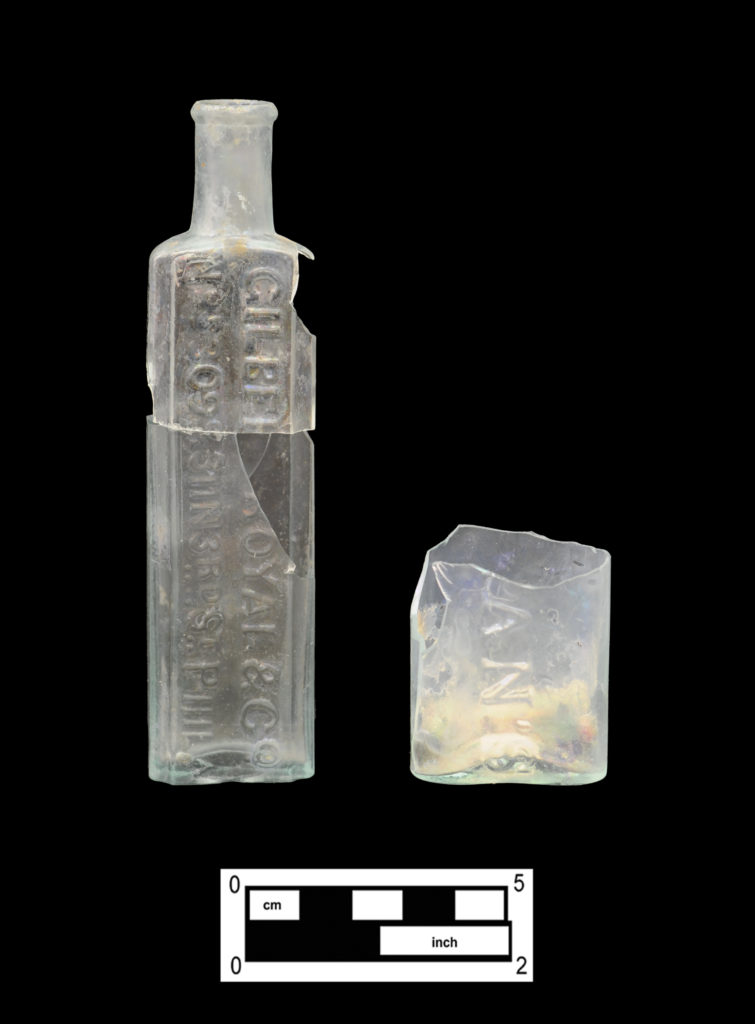
A single small rectangular druggist bottle with chamfered corners bears the embossing “GILBERT, ROYAL & CO / NOS 309 & 311 N 3RD ST PHILA” (4A-G-0170) (Figure 2). The partnership of Gilbert, Royal & Company consisted of druggists John Gilbert, Theodore A. Royal, and Lewis Royer, who operated at 309 and 311 North 3rd Street in the Northern Liberties section of the city in the early 1860s. The partnership was listed in the city directories from 1861 to 1864, though it may have persisted several years longer until the new name “Gilbert & Royal” first appeared in 1868, and Lewis Royer was apparently no longer involved. 3 The name “Gilbert & Royal” appeared in the directories until 1871. 4 In 1872, the name again changed, this time to “John Gilbert & Company,” when Bethlehem, Pennsylvania, druggist Matthew M. Selfridge joined Gilbert and Royal’s business. 5 This name persisted until 1878, with several slight changes in the partnership over this final period, though the different manifestations of the company remained at 309 North 3rd Street throughout its entire existence. 6
Three small oval druggist bottles, bearing the simple embossing “VAUGHAN’S,” were recovered from behind 1018 Palmer Street (4A-G-0094; 4A-G-0342; 4A-G-0348) (Figure 2). George Washington Vaughan, who operated at the intersection of Richmond and Shackamaxon Streets for the large majority of his career, likely distributed these bottles . Vaughan began as a druggist at Beach above Maiden around 1838, before quickly relocating to Richmond and Shackamaxon, and remaining in business there until his death in 1873. 7 George W. formed an apparently brief partnership with his brother Thomas W. under the name “G. W. Vaughan & Brother,” though this company name appeared in the city directories only from 1849 to 1852. 8

Two small oval druggist bottles recovered from this shaft bear the identical embossing—“A. COMFORT / PHIL.A”—and date from the 1850s, though they are slightly different sizes and possess two different types of finishes (4A-G-0344; 4A-G-0350) (Figure 3). Aaron Comfort appeared in the city directories listed merely as “Thomsonian Medicines” from 1839 through 1857.” 9 The Thomsonian System of Medicine was founded by Samuel Thomson, “an itinerant healer” who established botanical cures for illnesses and was opposed to the bleeding and physics the physicians of the day often prescribed. 10 Thomson’s practice of medicine espoused that cold temperatures, or merely the loss of heat, was the universal cause of disease. 11 It maintained that “internal heat” was the cause of life and motion, or simply that “heat is life, and cold, death. 12” As an alternative medicine, Thomsonian medicine relied on treatments that were supposed to restore the body’s “internal heat,” such as cayenne pepper, laxatives, Lobelia inflate to induce vomiting, and steam baths. 13
After completing his medical training at Thomas Jefferson Medical School, Dr. John W. Comfort went on to become a practitioner of Thomsonian medicine in Philadelphia. Dr. Comfort authored two books that detailed Thomson’s treatments and provided his additional treatments from his own experiences in treating many common diseases. His brother Aaron Comfort operated a drug store at 295 Market Street in Philadelphia, compounding prescriptions in accordance with Thomsonian practice and offering copies of John’s manuals for sale. 14 While the original contents of the recovered bottles are unknown, it is likely that they provided a botanical-based treatment for a member of the Cramp family.
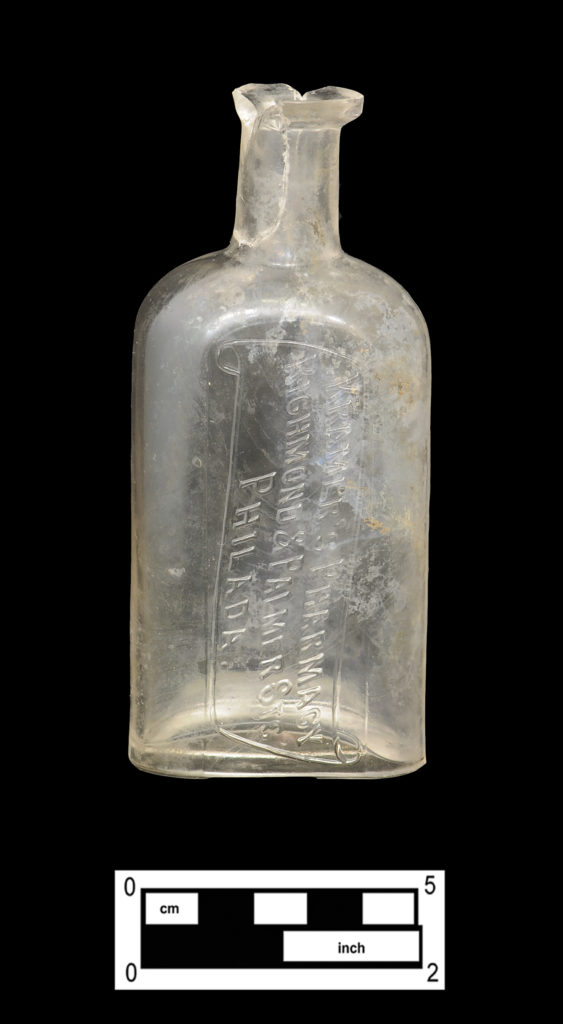
A small oval druggist bottle represents a local business that was undoubtedly a Fishtown neighborhood mainstay during the late nineteenth and early twentieth centuries. Embossed “KRAMER’S PHARMACY / RICHMOND & PALMER STS / PHILADA.” (all within a scroll), this bottle was likely sold only feet from where it was ultimately deposited (4A-G-0108) (Figure 4). After spending eight years working as a drug store clerk and living at a different address during practically every one of these years, Ira Daniel Webster Kramer (b. 1852–d. 1932) was first listed as a druggist at the corner of 6th and Buttonwood in 1883. 15 In 1884, Kramer relocated to Fishtown, where he found stability and established his pharmaceutical business at 461 Richmond Street, only several doors away from 1018 Palmer. 16 An alumnus of the Philadelphia College of Pharmacy and a registered pharmacist with the Pennsylvania State Board of Health, Kramer remained at 461 Richmond through the first quarter of the twentieth century. Indeed, as late as the 1930 federal census, Kramer—by then 77 years old—was still listed as a druggist owning his shop on Richmond Street, 45 years after first moving into the neighborhood. 17 The bottle recovered from behind 1018 Palmer Street bears a “W” within a diamond on its base, a mark of the Whitney Glass Works in Glassboro, New Jersey. The combination of this mark and the presence of minimal air venting on the bottle likely date it to the 1890s, making it an object a member of the Bumm family probably purchased and deposited.
Patent or Proprietary Medicine
While the term “patent medicines” has become popular when referring to these bottles, in reality very few of the nineteenth- and early-twentieth-century products sold in these containers were patented. The term “proprietary” is actually more appropriate, as these compounds were frequently the branded products of an individual or company. The contents and proclaimed benefits of many of the proprietary medicines were often misleading and, in some cases, fraudulent. Some of these products did little of what was advertised and even harmed the users.
In the discussion that follows, these proprietary medicines are organized based on the illnesses or diseases they claimed to treat.
Stomach and Liver Complaints
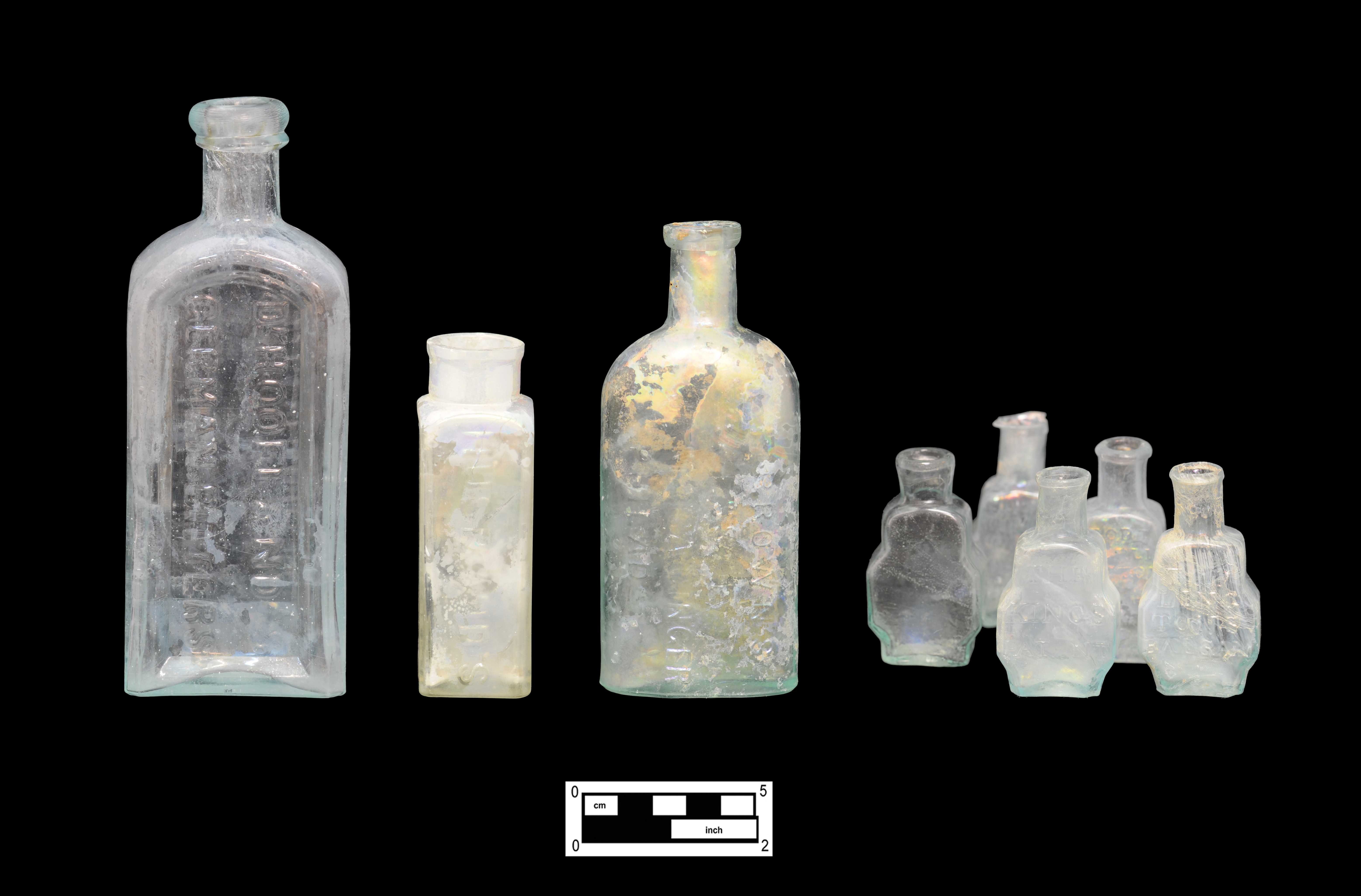
Six bottles of Hoofland’s German Bitters were recovered from this shaft (4A-G-0040; 0074; 0093; 0096; 0097; 0290) (Figure 5). This product was invented in Germany in the 1840s and introduced in America around 1850 by Philadelphia druggist Charles M. Jackson. As described in the embossing on the bottle, Hoofland’s German Bitters was meant to treat “Dyspepsia” and “Liver Complaint.” The brand was sold to Charles M. Evans, a former clerk in Jackson’s firm, in 1863 and later to Johnston, Holloway & Company in the 1870s. The variety of pontil-scarred, hinge-molded, and post-bottom molded bases on the bottles recovered from Feature 2 indicates that this product was likely used repeatedly for an extended period of time in the Cramp household, though the majority of these examples likely date to the 1860s.
Three Husband’s Calcined Magnesia bottles were recovered from Feature 2 behind 1018 Palmer Street (Cat # 4.24.348; 4A-G-0070; 4A-G-0150) (Figure 5). In 1844, Philadelphia chemist Thomas Jewett Husband introduced this product, advertised as a remedy for indigestion, heartburn, dyspepsia, and other stomach complaints. 18 Husband’s product, and even the bottle itself, was a direct copy of Henry’s Calcined Magnesia, first introduced in 1772 by Englishmen Thomas and William Henry and available in the United States by 1804. 19 Husband likely introduced his domestically produced product as a result of the increased import costs that made Henry’s Calcined Magnesia significantly more expensive. Husband’s son, Thomas Jewett Jr., joined his father’s business at the intersection of 3rd and Spruce in 1867, and continued operating well after Thomas Sr.’s death in 1898. Indeed, Husband’s Calcined Magnesia bottles still appeared into the 1920s, though the examples recovered from this shaft feature likely date between the late 1860s and the early 1880s.
Members of this household also relied on another preparation to treat digestive ailments—as evidenced in the recovery of an oval aqua bottle embossed “F BROWN’S / ESS OF / JAMAICA GINGER / PHILADA” (4A-G-0148) (Figure 5). Frederick Brown had established himself as a “chemist and druggist on the north east corner of Chestnut and Fifth” Streets in Philadelphia by 1823. 20 Brown offered a variety of proprietary medicines, both wholesale and retail.
The first newspaper advertisement for Brown’s Essence of Jamaica Ginger appeared in the Philadelphia Inquirer on January 10, 1848. Brown promoted his Jamaica ginger as a cure for cholera, diarrhea, nausea, and sea sickness, recommending it as a treatment for the whole family.
A few drops imparting to the stomach a glow and vigor, equal to a wine glass full of brandy or other stimulant, without any of the debilitating effects which are sure to follow the use of liquor of any kind; and it is therefore especially serviceable to children and females. 21
Brown’s early advertisements likened his Jamaica ginger to an English brand called Oxley’s Essence of Ginger. 22 The recipe for Oxley’s was recorded in The Complete Cook, published in Philadelphia in 1846. “The best Jamaica or China ginger two ounces, proof spirit one pint. Powder the ginger, mix it with the spirit, stop close, and let it steep for twelve or fourteen days.” 23 Later recipes for “Essence of Ginger” show the continued inclusion of large amounts of alcohol in the formulation. The Bulletin: Patent or Proprietary Medicine, published by the Ohio Dairy and Food Department in 1909, listed Brown’s Essence of Jamaica Ginger with an alcohol content of 75%. 24
After Brown’s death in 1864, his son Fred Jr. led the business and the company continued to sell Brown’s Jamaica ginger into the twentieth century. 25 The bottle found behind 1018 Palmer features an applied finish, smooth, post-bottom molded base, and lacks any evidence of air venting. These attributes combine to indicate a likely manufacturing date range for the bottle sometime in the 1860s or 1870s, probably used and discarded by a member of the Cramp family.
In all, nine small Turlington’s Balsam of Life bottles were recovered from Feature 2 (4A-G-0012; 0083; 0084; 0112; 0177; 0178; 0179; 0346; 0351) (Figure 5). Introduced in 1744 by Robert Turlington of London, Turlington’s Balsam of Life was promoted as a cure-all for kidney and bladder stones, colic, and “inward weaknesses.” 26 A period source, The Druggists Hand book of Private formulas (1882), provided a list of the ingredients and described two specific uses: “Dose, thirty drops to two drachms as an expectorant. Externally used for indolent (chronic) ulcers, etc.” 27 The distinctive pear-shaped form shown here first appeared in the 1750s, and was produced in large numbers well into the nineteenth century. Many American glassworks are known to have copied these bottles in the nineteenth century, including the nearby Kensington and Dyottville Glassworks. The copies Thomas D. Dyott produced at his glassworks stand out because they bear the misspelled word “BALSOM” rather than “BALSAM.” 28 Unfortunately, none of the bottles recovered from Feature 2 include this misspelling, so it is impossible to definitively attribute them to Dyott. Each of the bottles recovered, however, does bear some slightly different variation of the original embossing, so they still likely represent American copies.
A single bottle embossed “E. F. KUNKEL’S // BITTER / WINE OF IRON // PHILADELPHIA, PA.” was also recovered from this shaft, and would have contained yet another product advertised to treat stomach problems (Figure 5). Edwin F. Kunkel seems to have begun selling patent medicines in Philadelphia late in 1871, establishing his long-lived business at 259 North 9th Street by 1872. 29 Kunkel’s Bitter Wine of Iron was designed primarily to treat “nervous debility,” 30 but its proclaimed cures were wide ranging:
E. F. Kunkel’s celebrated Bitter Wine of Iron will effectually cure liver complaint, jaundice, dyspepsia, chronic or nervous debility, chronic diarrhea, disease of the kidneys and all diseases arising from a disordered liver, stomach or intestines, such as constipation, flatulence, inward piles, fullness of blood to the head, acidity of the stomach, nausea, heartburn, disgust for food, fullness or weight in the stomach, sore erections, sinking or fluttering at the pit of the stomach, fluttering at the heart, choking or suffocating sensation when in a lying posture, dimness of vision, dots or webs before the sight, dull pain in the head, deficiency of perspiration, yellowness of the skin and eyes, pain in the side, back, head, chest, limbs, etc., sudden flushes of heat, constant imaginings of evil and great depression of spirits. 31
Basically, Kunkel’s Bitter Wine of Iron claimed that it could strengthen a weakened nervous system by “enriching the blood.” 32 It seemed to target nearly all symptoms of emotional distress, promising to improve sleep, appetite, and energy. 33 Its strong alcohol base would surely have helped appease its users. The bottle recovered from Feature 2 was likely made and sold in the 1870s, and would have once born a yellow wrapper around it, complete with Kunkel’s image.
Treating Diseases of the Lungs
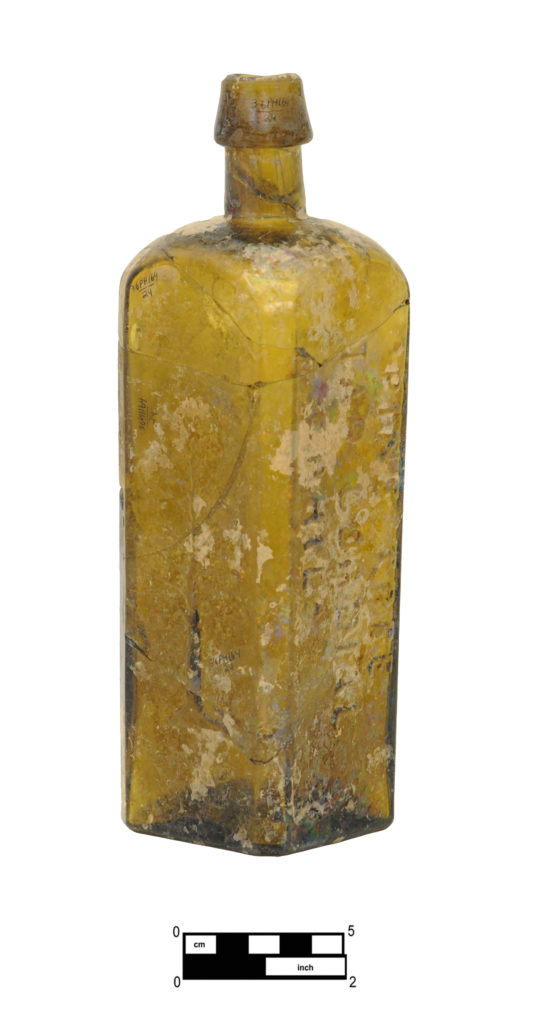
L. Q. C. Wishart’s Pine Tree Tar Cordial was a flavored alcoholic beverage meant to treat “Consumption of the Lungs, Cough, Sore Throat and Breast, Bronchitis, Liver Complaint, Blind and Bleeding Piles, Asthma, Whooping Cough and Diptheria, &c” (4A-C-053) (Figure 6). 34 Lucius Quintus Cincinnatus (L. Q. C.) Wishart, a Philadelphia grocer, likely introduced his pine tree tar cordial sometime in the mid-1850s. The product was later sold by Wishart’s son, Henry R., beginning around 1870, and Philadelphia druggists Harry C. and John Campion (aka Harry Campion & Sons) into the early 1900s. 35 The nearly complete, mended cordial bottle shown here, with its iron pontil-scarred base, likely represents the earliest of the many variants, dating between circa 1855 and 1858, and thus is related to the Cramp family’s occupation of 1018 Palmer Street.
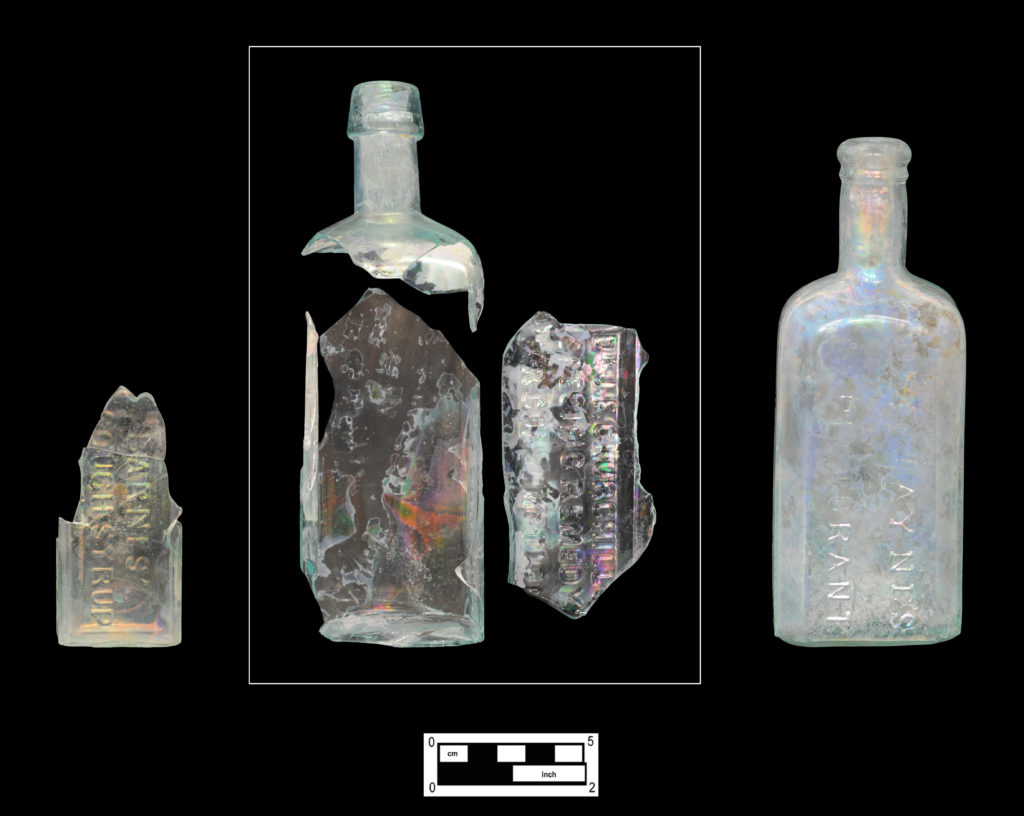
Another medicine for the treatment of respiratory ailments is represented by fragments of a rectangular panel bottle embossed “Barnes’ Cough Syrup” (4.24.317) (Figure 7). The base of this bottle reveals that it was blown in a two-piece mold with an open pontil scar evident—characteristics that suggest a date of manufacture prior to the mid-1860s. 36 Between 1854 and 1858, Dr. Barnes sold his cough syrup, along with various other remedies, from his drug store at 20 East State Street in Trenton, New Jersey. 37 His cough syrup, made from vegetable extracts, was advertised as a cure for illnesses of the throat and lungs, including chronic diseases such as consumption (tuberculosis). An advertisement in the Trenton State Gazette from March 21, 1856 noted that Barnes’ cough syrup was available at “Mellor 113 Walnut Street Phila and Mihall 183 Broadway NY.” 38
A single bottle of Dr. J. F. Churchill’s Specific Remedy for Consumption was recovered from the privy shaft behind 1018 Palmer Street (4A-G-0313) (Figure 7). In July of 1847, Dr. J. Francis Churchill first presented his theory about the cause for consumption, now known as tuberculosis. Churchill blamed tuberculosis on poor oxidation, and suggested the use of the hydrophosphate in his tonic to strengthen the lungs. Churchill’s recipe was introduced into the United States in the very late 1850s, and Jonas Winchester of New York manufactured his “Specific Remedy.” The bottle recovered from site would have been made sometime between the very late 1850s and the early 1870s, and likely would have been used by a member of William G. Cramp’s household.
Feature 2 also produced five Dr. D. Jayne’s Expectorant bottles (Cat # 4.24.287; 4A-G-0025; 0026; 0092; 0147) (Figure 7). An expectorant is a product that promotes the expulsion of mucus and phlegm. During the last quarter of the nineteenth century, Dr. D. Jayne’s Expectorant was advertised as a cure for coughs, colds, and all forms of lung, throat, and bronchial problems, as well as asthmatic conditions, pleurisy, and inflammation of the lungs. While Jayne’s Expectorant may have indeed helped with coughs and colds, it is unlikely that it did much for the relief of whooping cough, another advertised use for the product. The four bottles recovered from Feature 2 likely date to the last quarter of the nineteenth century.
Treatment of Parasites
Two different small patent medicine bottles recovered from behind 1018 Palmer Street represent a common health concern during the middle of the nineteenth century. One, a small rectangular paneled bottle, reads “HOBENSACK’S // MEDICATED / WORM SYRUP // PHILADA” (likely 1850s—early 1860s); the second, a small oval bottle, reads “SWAIM’S / VERMIFUGE // DYSENTERY / CHOLERA MORBUS / DYSPEPSIA” (4A-G-0317; 4A-G-0095) (Figure 8). Both of these products were meant to treat parasites, particularly worms. Threadworms, roundworms, and tapeworms appear to have been the primary concerns of the time, and indeed, a wide variety of products—including worm cakes, worm powders, worm syrups, worm teas, vermifuge lozenges, and worm rubs containing Vaseline for application to the parts affected—were sold. 39 Mackenzie’s Five Thousand Receipts listed the common symptoms of worms as “Intolerable itching at the nose, sometimes at the fundament, disagreeable breath, grinding of the teeth and starting during sleep, hardness of the belly, gradual emaciation, colic, and sometimes convulsions.” 40 In children, the prime indicators of worms seemed to be nose picking and loss of appetite, often compelling mothers and nurses to administer vermifuges. According to Proctor, however, products such as Hobensack’s Medicated Worm Syrup would purge a child of worms, but also induce a subsequent violent disease or sickness. 41 Such harmful side effects may not have been an exaggeration, as various vermifuge treatments did include large quantities of gin, castor oil, “tobacco leaves, pounded with vinegar,” and turpentine. 42
Medicine for Women

Two bottles embossed “Dr. Pierce’s Favorite Prescription” are represented by base fragments that appear to be identical, though the shade of aqua and quality of the embossing differ slightly (Cat # 4.24.289; 4.27.69) (Figure 9). Both paneled bottles were blown into a cup bottom mold, and although the finishes and shoulders are missing, the dullness of the embossing makes it unlikely that air venting was used on either. As a result, both bottles likely date from the introduction of the product in 1867 to no later than the mid-to-late 1880s.
Dr. Ray Vaughan Pierce introduced this tonic shortly after he arrived in Buffalo, New York, in 1867; it continued to be sold with great popularity into the early twentieth century. Advertised as a uterine tonic designed to “regulate the menstrual function,” Pierce prescribed his “Favorite Prescription” as treatment for a wide variety of diseases involving the female reproductive organs. 43
Elizabeth Cramp’s Cancer
Elizabeth Cramp died shortly after the family moved from 1018 Palmer Street to their new home at 1906 Diamond Street in April of 1889. A large number of medicine bottles dating from the third quarter of the nineteenth century were recovered from the shaft feature behind their former residence. The identified medicines and unmarked apothecary bottles and vials appear to be well in excess of what might be expected from the small number of family members occupying this household. Elizabeth’s somewhat sudden death and the quantities of medicine bottles recovered from the Palmer Street privy left us wondering if there was some connection. Her death certificate reveals that she died of cancer of her reproductive organs on October 23, only six short months after the move.
We do not know the extent of the disease or what treatments Elizabeth may have received, but it is likely that the cancer had spread. In the final stage, this type of cancer often metastasizes to other reproductive organs, bladder, rectum, lungs, or bones. It is possible that Elizabeth relied on a number of different medicines to alleviate a wide range of symptoms associated with the metastasis. 44
A publication from 1888 maintained that the “Favorite Prescription” “improves digestion, enriches the blood, exercises a tonic and gently stimulating effect upon the uterus and ovaries, and thus promotes the function of menstruation.” 45 In 1902, an advertisement from a local Buffalo newspaper claimed that “The best medicine for girls who are nervous, melancholy, and irregular of appetite is Dr. Pierce’s Favorite Prescription. It cures nervousness, dizziness and melancholy, promotes the appetite, and gives the body robust health.” 46
An independent lab analysis in 1902 identified the tonic’s ingredients as savin, cinchona, agaric, cinnamon, water, acacia, sugar, digitalis, opium, oil star anise, and alcohol. Many of the herbal ingredients in the “Favorite Prescription” would have indeed contributed to the many claimed benefits of the product. Cinchona acts as a painkiller, while agaric aids in preventing perspiration. Digitalis would have decreased a woman’s pulse rate and improved pumping action of the heart, calming her nerves, and it is believed that oil star anise stimulates healthy digestion.
Acacia and savin, on the other hand, would have had slightly more damaging side effects. Acacia is believed to dampen one’s libido, while savin—the extract of juniper berries—induces menstruation. If a woman or girl were to consume Dr. Pierce’s Favorite Prescription regularly, the savin in the product would cause her to constantly menstruate and therefore make pregnancy impossible. Frequent consumption may have been common, especially in light of the opium (an addictive narcotic) in the product. This reality may have induced some users to consume the “Favorite Prescription” as a form of birth control, but also introduces the possibility of another more dangerous use. According to Larkin, savin was also used as an abortion-inducing drug. 47
Unmarked Bottles
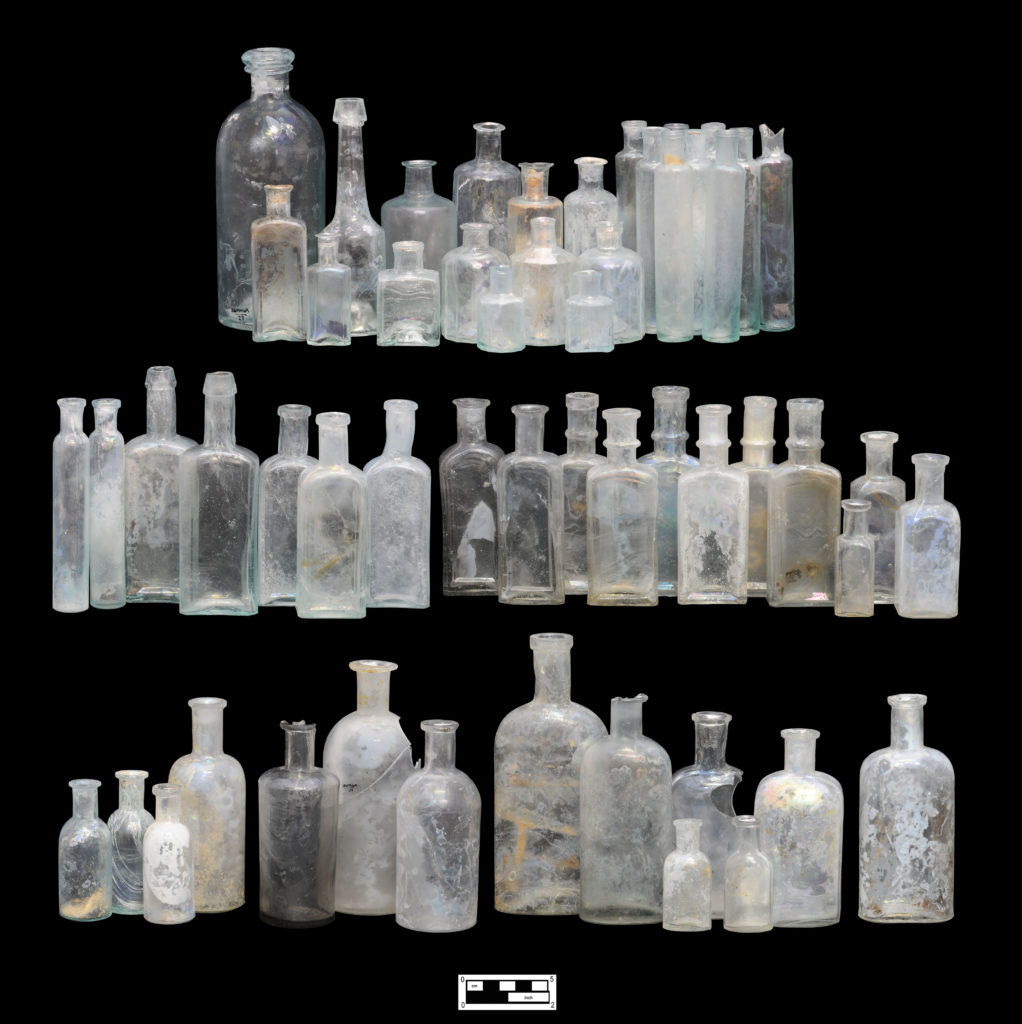
Among the many embossed bottles recovered from the 1018 Palmer Street privy were an even greater number of unmarked bottles. (Figure 10) These unembossed bottles would have originally only had paper labels, and because none of these labels have survived in the ground, the specific products once contained in these bottles are unknown (though based on forms the vast majority were likely medicinal). While the absence of proprietary embossing prevents very refined dating, the manufacturing characteristics of the bottles themselves still allow for the identification of 10-15 year production date ranges for each bottle. Despite the fact that dozens of “slicks” (as unembossed bottles are commonly known to collectors) were found, all seem to have been produced during the Cramp family occupation of 1018 Palmer Street.
The lack of significant numbers of medicine bottles from the subsequent Bumm & Nickel families’ occupations of the residence is noteworthy (despite the presence of other artifact types related to these families), and raises questions related to the health of the Cramp family and/or their consumption habits. Could Elizabeth Cramp’s apparently lengthy illness be the cause of the abundant numbers of medicine bottles dating to the Cramp period of occupation? Is there significance in the owner (Cramp) vs. renter (Bumm/Nickel) characteristic of the occupations in relation to trash disposal, especially when considering that the Cramps and Bumms were at the address for similar lengths of time? These and other factors likely played a role in the discrepancy in the quantities of medicine bottles between the households, and the identification of these factors rests with future comparisons to other households within the I-95 project area.
Likewise, 1018 Palmer Street’s proximity to the pharmacies at 461 Richmond Street (only several doors away), introduces another degree of complexity in interpreting these discrepancies. While there may have been a pharmacy at this location prior to ca. 1854, beginning around this time three consecutive drug stores operated at the corner of Richmond & Palmer Streets until at least the 1930s, with ownership changes occurring ca. 1868 and 1884. 48 Indeed, a late 19th century bottle for Ira D. W. Kramer’s pharmacy (the last manifestation, operated between 1884 and the 1930s) was recovered from the feature and is discussed elsewhere in this report. Could the relationships between the Cramps and the different druggists at this location have played a factor? Were there differences in the re-use of bottles between the three druggists that would have manifested in the frequency of discard of their containers? Further investigation is certainly needed. What is certain, however, is that despite the large numbers of unembossed bottles recovered from the 1018 Palmer Street privy, all were produced during the Cramp occupation of the address, and represent the entire Cramp period at this location.
Ceramic Ointment Containers
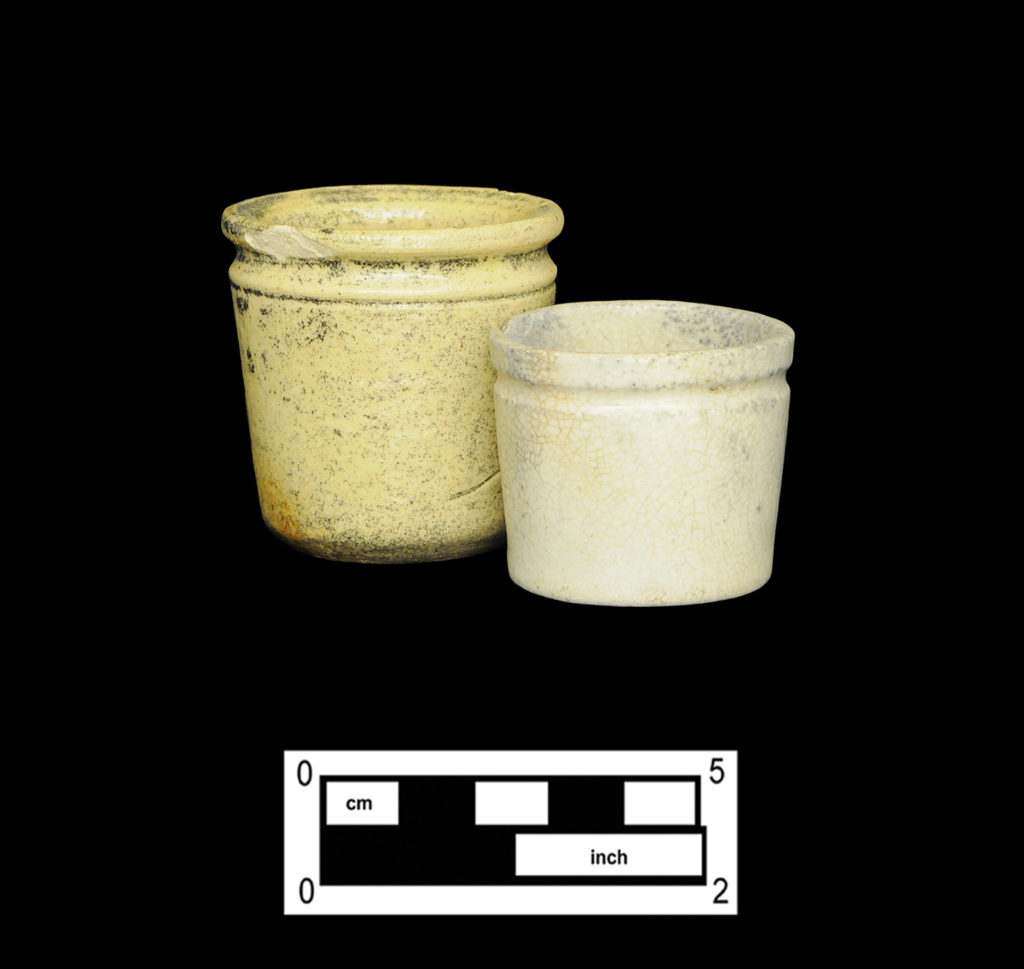
Two small unmarked ceramic vessels probably once held some type of medicinal ointments (4A-C-0028, 4A-C-0113) (Figure 11). Although similar in form, the containers differ slightly in height and color of ceramic body. The taller pot was formed from a buff -yellow clay, while the other example is made of refined white clay. Both pots feature a tooled lip with a groove designed for securing a lid or cover. Some of the dark staining and adhered patchy grit suggests damage during kiln firing; however, this is common on small pharmaceutical pots and would not have prevented their use.
Other Medical Devices
Two additional artifacts represent devices used to administer specific types of medication.
White Metal Syringe
A nearly complete white metal syringe was recovered from behind 1018 Palmer Street (Cat # 4.24.509) (Figure 12). Pewter syringes were largely replaced by hard rubber varieties after 1851, but continued to be depicted in medical literature, albeit less frequently, as late as the early 1860s. 49 Because the first hypodermic syringes weren’t developed until 1853, it is likely that this metal syringe served some other purpose. 50 While only the barrel and plunger of this syringe remain, the size and form do resemble vaginal/douching syringes of the mid-nineteenth century. Douching with syringes, used as a form of birth control and for hygienic purposes, became increasingly popular after 1830, and the varied devices for douching could be purchased from neighborhood pharmacies or through the mail. 51 An “Improved Female Syringe” was advertised as early as 1837, and included an ivory tube and shield attached to the pewter barrel of the syringe at an 85-degree angle. 52 One particular astringent recipe described in 1854 that would have been administered through a douching syringe consisted of one pint of decoction of bark—basically the essence of bark extracted through boiling—and three drams of alum powder. 53
Cushman’s Menthol Inhaler

This small glass tube posed a bit of a mystery when first recovered. Was it part of a glass syringe, a test tube, or perhaps a tiny vase for a boutonnière? The identity of this artifact was revealed by means of an image from an advertising trade card that we were intending to use to illustrate children’s toys. Although portions of the description on the back of the card had been trimmed away, enough information survived to connect the product—Cushman’s Menthol Inhaler—with this glass tube (Cat # 4.22.21) (Figure 12). We confirmed the object was part of an inhaler by comparing the glass artifact with surviving devices offered in online auctions. Some of the images showed that the Cushman’s inhaler had a distinct yellow label and, upon closer inspection, the artifact retained a small portion of a similar label.
On January 5, 1886, Henry D. Cushman of Three Rivers, Michigan, received U.S. Patent number 333,608 for an inhaler, open at both ends, that allowed air to pass through the tube when in use. 54] Cushman’s device provided a container and system of delivery for inhaling vapor produced by menthol crystals. He recommended the tube be formed of either glass, hard rubber, celluloid, or other material with dimensions of between four and five inches in length and a half inch in diameter. 55 While the illustration of the inhaler included in the patent shows a straight tube with the same dimension along the entire length, the recovered glass tube is tapered at one end. An image of a Cushman’s inhaler that more closely matches the archaeological example appeared in an advertisement in The Daily Review, dated August 29, 1886. 56
Cushman’s was marketed as a treatment for “Neuralgia, Headache, Catarrh, Asthma, Bronchitis, Sore Throat, Earache, Toothache and all diseases of the throat and lungs.” 57 The menthol crystals likely had an effect similar to modern menthol nasal inhalants, providing temporary relief from upper respiratory conditions.
Bottled Cures—for Better or Worse
The identifiable medicine bottles from this feature provide insights into the common illnesses and symptoms that afflicted the various occupants of 1018 Palmer Street. This feature assemblage contains bottles for medicines prescribed and prepared by physicians and pharmacists, as well as a wide range of proprietary medicines individuals in this household selected for self-medication.
References
- Isaac Ashmead & Co., comp., A. McElroy’s Philadelphia Directory for 1844, “Philadelphia City Directories,” subscription database accessed December 2016, https://www.fold3.com, entry for Edwin Meredith & Co., p. 215.; Edward C. & John Biddle, comp., A. McElroy’s Philadelphia Directory for 1850, “Philadelphia City Directories,” subscription database accessed December 2016, https://www.fold3.com, entry for Edwin Meredith & Co., p. 285. ↩
- Edward C. & John Biddle, comp., A. McElroy’s Philadelphia Directory for 1847, “Philadelphia City Directories,” subscription database accessed December 2016, https://www.fold3.com, entry for Thompson & Crawford, p. 345.; McElroy’s Philadelphia Directory for 1861, , entry for Thompson & Crawford, p. 986. ↩
- E. C. & J. Biddle & Co., comp., A. McElroy’s Philadelphia Directory for 1861, “Philadelphia City Directories,” subscription database accessed December 2016, https://www.fold3.com, entry for Gilbert, Royal & Co., p. 353.; McElroy’s Philadelphia Directory for 1864, entry for Gilbert, Royal & Co., p. 266.; James Gopsill, comp., Gopsill’s Philadelphia City Directory, 1868, “Philadelphia City Directories,” subscription database accessed December 2016, https://www.fold3.com, entry for Gilbert & Royal, p. 650. ↩
- James Gopsill, comp., Gopsill’s Philadelphia City Directory, 1871, “Philadelphia City Directories,” subscription database accessed December 2016, https://www.fold3.com, entry for Gilbert & Royal, p. 596. ↩
- James Gopsill, comp., Gopsill’s Philadelphia City Directory, 1872, “Philadelphia City Directories,” subscription database accessed December 2016, https://www.fold3.com, entry for John Gilbert & Co., p. 560. ↩
- Isaac Costa, comp., Gopsill’s Philadelphia City Directory, 1878, “Philadelphia City Directories,” subscription database accessed December 2016, https://www.fold3.com, entry for John Gilbert & Co., p. 598. ↩
- Isaac Ashmead & Co., comp., A. M’Elroy’s Philadelphia Directory for 1839, “Philadelphia City Directories,” subscription database accessed December 2016, https://www.fold3.com, entry for George W. Vaughan., p. 260.; James Gopsill, comp., Gopsill’s Philadelphia City Directory, 1873, “Philadelphia City Directories,” subscription database accessed December 2016, https://www.fold3.com, entry for George W. Vaughan, p. 1310. ↩
- Edward C. & John Biddle, comp., A. McElroy’s Philadelphia Directory for 1849, “Philadelphia City Directories,” subscription database accessed December 2016, https://www.fold3.com, entry for G. W. Vaughan & Brother, p. 386.; McElroy’s Philadelphia Directory for 1852, entry for G. W. Vaughan & Brother, p. 452. ↩
- Isaac Ashmead & Co., comp., A. McElroy’s Philadelphia City Directory for 1839, “Philadelphia City Directories,” subscription database accessed October 2016, https://www.fold3.com, entries for Aaron Comfort, p. 51; McElroy’s Philadelphia Directory for 1857, entry for Aaron Comfort, p. 122. ↩
- John S. Haller Jr., The People’s Doctors (Carbondale and Edwardsville, IL: Southern Illinois University Press, 2000), 15. ↩
- J. W. Comfort, The Practice of Medicine on Thomsonian Principles, Adapted as Well to the Use of Families as to that of the Practitioner (Philadelphia, PA: C. Sherman, 1850), xxii. ↩
- Ibid. ↩
- Ibid., xxiii. ↩
- Haller, People’s Doctors, 116. ↩
- Gopsill’s Philadelphia City Directory, 1883, “Philadelphia City Directories,” subscription database accessed January 2017, https://www.fold3.com, entry for I. D. W. Kramer, p. 905. ↩
- Gopsill’s Philadelphia City Directory, for 1885, “Philadelphia City Directories,” subscription database accessed January 2017, https://www.fold3.com, entry for Ira D. W. Kramer, p. 997. ↩
- “1930 United States Federal Census,” Ancestry.com, subscription database accessed January 2017, http://www.ancestry.com, entry for Ira D. Kramer, ED 0828, 18th Ward, Philadelphia, Pa. ↩
- “SS Republic Artifacts: Husband’s Calcined Magnesia Bottle,” Odyssey’s Virtual Museum, accessed June 2013, http://www.odysseyvirtualmuseum.com/products/Husband%27s-Calcined-Magnesia-Bottle.html. ↩
- Ibid. ↩
- Robert DeSilver, comp., The Philadelphia Index, or Directory, for 1823, “Philadelphia City Directories,” subscription database accessed January 2017, https://www.fold3.com, entry for Frederick Brown, p. ↩
- “Brown’s Essence of Jamaica Ginger” advertisement, Charleston Courier, January 5, 1850, p. 1, Genealogy Bank, subscription database accessed January 2017, http://www.genealogybank.com. ↩
- “Brown’s Essence of Jamaica Ginger,” advertisement, Philadelphia Inquirer, January 21, 1848, p. 1, Genealogy Bank, subscription database accessed January 2017, http://www.genealogybank.com. ↩
- J. M. Sanderson, The Complete Cook (Philadelphia, PA: Lea and Blanchard, 1846), 82, accessed January 2017, https://books.google.com/books?id=YAAqAAAAYAAJ&pg=RA1-PA82&lpg=RA1-PA82&dq=oxleys+essence+of+ginger&source=bl&ots=LVZt90lyP5&sig=aKczERyGUB6bkRdURllzwjEh3Xw&hl=en&sa=X&ved=0ahUKEwid7eOrh8rRAhXGj1QKHfYeBzgQ6AEILzAJ#v=onepage&q=oxleys%20essence%20of%20ginger&f=false. ↩
- Renick W. Dunlap, Bulletin: Patent or Proprietary Medicine by Ohio Dairy and Food Dept. (Springfield, OH: Springfield Publishing Co State Publishers, 1909), 14, accessed January 2017, https://books.google.com/books?id=6vw0AQAAMAAJ&pg=PA14&lpg=PA14&dq=Brown%27s+essence+of+jamaica+ginger&source=bl&ots=rbqJ0QskYq&sig=-vF2QqzLf10do3yE1X7V9o6niUU&hl=en&sa=X&ved=0ahUKEwiClvfSsNPPAhVi7IMKHZtuB544ChDoAQheMAg#v=onepage&q&f=false. ↩
- George Griffenhagen and Mary Bogard, History of Drug Containers and their Labels (Madison, WI: American Institute of the History of Pharmacy, 1999), 79.; Richard E. Fike, The Bottle Book (Caldwell, NJ: The Blackburn Press, reprint 2006), 128. ↩
- Griffenhagen and Bogard, History of Drug Containers, 73. ↩
- John H. Nelson, The Druggists Hand Book of Private Formulas (New York, NY: J.H. Vail & Co., 1882), 105. ↩
- Griffenhagen and Bogard, History of Drug Containers, 76. ↩
- James Gopsill, comp., Gopsill’s Philadelphia City Directory 1872, “Philadelphia City Directories,” subscription database accessed February 2017, https://www.fold3.com, entry for E. F. Kunkel, 795; Gopsill’s Philadelphia Directory 1873, entry for E. F. Kunkel, 771. ↩
- “Nervous Debility. Nervous Debility.” advertisement, The Times (Bloomfield, PA), January 23, 1877, p. 5. ↩
- “E. F. Kunkel’s Bitter Wine of Iron” advertisement, Harrisburg Daily Independent (Harrisburg, PA), May 10, 1877, p. 3, Newspapers.com, subscription database accessed February 2017, http://www.newspapers.com. ↩
- “Kunkel’s Bitter Wine of Iron, that boon to the weak, suffering and debilitated” advertisement, Patriot (Harrisburg, PA), August 11, 1906, p. 10, Genealogy Bank, subscription database accessed February 2017, http://www.genealogybank.com. ↩
- R. Gregory Lande, Psychological Consequences of the American Civil War (Jefferson, NC: McFarland & Company, Inc., 2017), 189. ↩
- Richard E. Fike, The Bottle Book (Caldwell, NJ: The Blackburn Press, reprint 2006), 87. ↩
- John R. Pastor, American Glass Gallery, Auction #13 (Lansing, MI: Spartan Printing, 2014), 3. ↩
- Bill Lindsey, “Bottle Base,” Historic Glass Bottle Identification & Information Website, accessed October 5, 2016, https://sha.org/bottle/pontil_scars.htm. ↩
- “This is the Season” advertisement, Trenton State Gazette, February 8, 1854, p. 2, Genealogy Bank, subscription database accessed September 2016, http://www.genealogybank.com; “Frosted-Feet Barnes’ Remedy” advertisement, Trenton State Gazette, May 7, 1858, 3, Genealogy Bank, subscription database accessed September 2016, http://www.genealogybank.com. ↩
- “Medicines” advertisement, Trenton State Gazette, March 21, 1856, 3, Genealogy Bank, subscription database accessed September 2016, http://www.genealogybank.com. ↩
- The Pharmaceutical Era, The Era Formulary: 5000 Formulas for Druggists. (Detroit, MI: D. O. Haynes & Company, 1893), 261–262. ↩
- Colin Mackenzie, Mackenzie’s Five Thousand Receipts in All the Useful and Domestic Arts (Philadelphia PA: Hayes & Zell, 1854), 208. ↩
- William Proctor, Jr., ed., “ ‘Old Physic and Young Pharmacy,’ or ‘A Few Words with the Apothecary,’” American Journal of Pharmacy Vol 26 (Philadelphia, PA: Merrihew and Thompson’s Steam-Power Book and Job Printing Office, 1854), 381–384, accessed January 2017, http://library.si.edu/digital-library/book/americanjour26321854phil. ↩
- Mackenzie, Five Thousand Receipts, 208. ↩
- R. V. Pierce, The People’s Common Sense Medical Adviser in Plain English; or, Medicine Simplified (Buffalo, NY: World Dispensary Printing Office and Bindery, 1888), 342. ↩
- National Cancer Institute at the National Institutes of Health, U.S. Department of Health and Human Services, accessed January 27, 2017, https://www.cancer.gov/types/vaginal/patient/vaginal-treatment-pdq. ↩
- Scott Maruna, “Dr. Pierce’s Favorite Prescription,” accessed October 2016, http://biofort.blogspot.com/2008/12/dr-pierces-favorite-prescription.html. ↩
- Ibid. ↩
- Jack Larkin, The Reshaping of Everyday Life, 1790-1840 (New York, NY: Harper & Row, 1989), 198. ↩
- Edward C. & John Biddle, comp., McElroy’s Philadelphia Directory for 1855 (Philadelphia, PA: Edward C. & John Biddle, 1855), 89, Wm. R. Claridge, accessed August 2017, www.fold3.com; James Gopsill, comp., Gopsill’s Philadelphia City Directory 1868 (Philadelphia, PA: James Gopsill, 1868), 176, John G. Baker, accessed August 2017, www.fold3.com.; Gopsill, Gopsill’s Philadelphia City Directory for 1885, 997, Ira D. W. Kramer, accessed August 2017, www.fold3.com. ↩
- Case Western Reserve University, Syringes and Douching, Highlights of the Percy Skuy History of Contraception Gallery: 19th Century Artifacts, 2010, accessed July 2013, http://www.case.edu/affil/skuyhistcontraception/online-2012/19thCentury.html,; Henry H. Smith, M.D., The Principles and Practice of Surgery, Embracing Minor and Operative Surgery, with a Bibliographical Index of American Surgical Writes from the Year 1783 to 1860 (Philadelphia, PA: J. B. Lippincott, 1863). ↩
- Becton, Dickinson and Company, Syringe and Needle History (Franklin Lakes, NJ: Becton, Dickinson and Company, 2004). ↩
- Case Western Reserve University, Syringes and Douching. ↩
- John Forbes and John Conolly, eds., The British and Foreign Medical Review or Quarterly Journal of Practical Medicine and Surgery (London: John Churchill, 1838), 307. ↩
- Mackenzie, Five Thousand Receipts, 243. ↩
- United States Patent Office, Henry D. Cushman No. 333,608, January 5, 1886, Google Patents, accessed September 2016, https://patents.google.com/patent/US333608A/en. ↩
- Ibid. ↩
- “Hay Fever Sufferers Be Happy!” advertisement, The Daily Review, August 29, 1886, 2, Newspapers.com, subscription database accessed September 2016, http://www.newspapers.com. ↩
- Ibid. ↩







